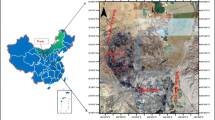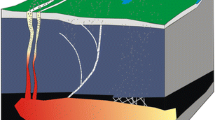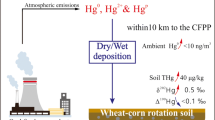Abstract
The coal fire area in the Wuda coalfield is divided into four parts based on the degree of burning and on surface characteristics: sub-area B is characterized by degraded vegetation, sub-area A has spontaneous combustion but no obvious features, sub-area O has vents and cracks, and sub-area C is characterized by red pyro-metamorphic rocks. Emitted gas contents and temperature at the surface were measured and analyzed. In addition, soil samples were collected for analysis of chemical soil properties. The compositions and concentrations of emitted gases vary from one sub-area to another. The nearly the same correlations among gas contents in sub-area A and in sub-area O indicate that their generation mechanism is the same. SO2, H2S, C2H6, C2H4, and C2H2 can only be detected near the cracks and vents in sub-area O. CO and H2 can still be detected in sub-area C, although the CO2 and CH4 contents in sub-area B are higher. Sub-areas A and B exhibit high organic matter contents due to plant nutrient accumulation and deposition of plant litter, whereas organic matter contents decrease at the vents and cracks in sub-area O and in sub-area C because of pyrolysis, leaching, and erosion. Soil near the vents and cracks in sub-area O show strong acidity, and soil pH is correlated with total salt contents of soil, which are composed mainly of Al-, K-, Mg-, or Fe-bearing sulfates. Sub-area A showed weak soil acidity, which was the result of acidification of pore water in soil due to their long-term exposure to CO2 and SO2. Total salt contents in soil in the coal fire area show no significant difference compared to those in the background area except near the vents and cracks in sub-area O. The findings of this study suggest that gas emission and soil chemical properties are reliably related to the underground coal fires.









Similar content being viewed by others
References
Carras, J. N., Day, S. J., Saghafi, A., & Williams, D. J. (2009). Greenhouse gas emissions from low-temperature oxidation and spontaneous combustion at open-cut coal mines in Australia. International Journal of Coal Geology, 78(2), 161–168.
Certini, G. (2005). Effects of fire on properties of forest soils: a review. Oecologia, 143(1), 1–10.
Cui, X. Y., Hao, J. M., Zhao, S. S., Sang, Y., Wang, H. Q., & Di, X. Y. (2012). Temporal and spacial changes of total soil organic carbon content as affected by an experimental forest fire in the Greater Xing’s a mountain. Journal of Soil and Water Conservation, 26(5), 195–200.
Dai, S. F., Ren, D. Y., Tang, Y. G., Shao, L. Y, & Li, S. S. (2002). Distribution, isotopic variation and origin of sulfur in coals in the Wuda coalfield, Inner Mongolia, China. International Journal of Coal Geology, 51(4), 237–250.
Derakhshan-Nejad, Z., Sun, J., Yun, S.-T., & Lee, G. (2019). Potential CO2 intrusion in near-surface environments: a review of current research approaches to geochemical processes. Environmental Geochemistry and Health, 41(5), 2339–2364.
Engle, M. A., Radke, L. F., Heffern, E. L., O’Keefe, J. M. K., Hower, J. C., Smeltzer, C. D., et al. (2012). Gas emissions, minerals, and tars associated with three coal fires, Powder River Basin, USA. Science of the Total Environment, 420, 146–159.
Engle, M. A., Radke, L. F., Heffern, E. L., O’Keefe, J. M. K., Smeltzer, C. D., Hower, J. C., et al. (2011). Quantifying greenhouse gas emissions from coal fires using airborne and ground-based methods. International Journal of Coal Geology, 88(2–3), 147–151.
Garrison, T., O’Keefe, J. M. K., Henke, K. R., Copley, G. C., Blake, D. R., & Hower, J. C. (2017). Gaseous emissions from the Lotts Creek coal mine fire: Perry County, Kentucky. International Journal of Coal Geology, 180, 57–66.
Harvey, O. R., Qafoku, N. P., Cantrell, K. J., Lee, G., Amonette, J. E., & Brown, C. F. (2013). Geochemical implications of gas leakage associated with geologic CO2 storage—a qualitative review. Environmental Science and Technology, 47(1), 23–36.
Hong, X. P. (2018). Fluorine and acid pollutant within soil around three coal-rich areas in China. China University of Mining and Technology (Beijing), Beijing (PhD Thesis).
Hower, J. C., Henke, K., O’Keefe, J. M. K., Engle, M. A., Blake, D. R., & Stracher, G. B. (2009). The Tiptop coal-mine fire, Kentucky: Preliminary investigation of the measurement of mercury and other hazardous gases from coal-fire gas vents. International Journal of Coal Geology, 80(1), 63–67.
Hower, J. C., O’Keefe, J. M. K., Henke, K. R., Wagner, N. J., Copley, G., Blake, D. R., et al. (2013). Gaseous emissions and sublimates from the Truman Shepherd coal fire, Floyd County, Kentucky: A re-investigation following attempted mitigation of the fire. International Journal of Coal Geology, 116–117, 63–74.
Kuenzer, C., & Stracher, G. B. (2012). Geomorphology of coal seam fires. Geomorphology, 138(1), 209–222.
Kuenzer, C., Zhang, J., Tetzlaff, A., van Dijk, P., Voigt, S., Mehl, H., et al. (2007). Uncontrolled coal fires and their environmental impacts: Investigating two arid mining regions in north-central China. Applied Geography, 27(1), 42–62.
Liang, Y. C. (2018). Emission characteristics of typical pollutants of coal fire in Wuda, Inner Mongolia. China University of Mining and Technology (Beijing), Beijing (PhD Thesis).
Liu, F. L., Xiao, H. H., & Luo, P. F. (2016). A Review: the effect of forest fire on soil organic matter. Chinese Journal of Soil Science, 47(1), 239–245.
Melody, S. M., & Johnston, F. H. (2015). Coal mine fires and human health: What do we know? International Journal of Coal Geology, 152, 1–14.
O’Keefe, J. M., Henke, K. R., Hower, J. C., Engle, M. A., Stracher, G. B., Stucker, J. D., et al. (2010). CO(2), CO, and Hg emissions from the Truman Shepherd and Ruth Mullins coal fires, eastern Kentucky, USA. Science of the Total Environment, 408(7), 1628–1633.
O’Keefe, J. M. K., Neace, E. R., Hammond, M. L., Hower, J. C., Engle, M. A., East, J., et al. (2018). Gas emissions, tars, and secondary minerals at the Ruth Mullins and Tiptop coal mine fires. International Journal of Coal Geology, 195, 304–316.
Querol, X., Zhuang, X., Font, O., Izquierdo, M., Alastuey, A., Castro, I., et al. (2011). Influence of soil cover on reducing the environmental impact of spontaneous coal combustion in coal waste gobs: A review and new experimental data. International Journal of Coal Geology, 85(1), 2–22.
Rasheed, M. A., Lakshmi, M., Rao, P. L. S., Kalpana, M. S., Dayal, A. M., & Patil, D. J. (2013). Geochemical evidences of trace metal anomalies for finding hydrocarbon microseepage in the petroliferous regions of the Tatipaka and Pasarlapudi areas of Krishna Godavari Basin, India. Petroleum Science, 10(1), 19–29.
Sechman, H., Kotarba, M. J., Fiszer, J., & Dzieniewicz, M. (2013). Distribution of methane and carbon dioxide concentrations in the near-surface zone and their genetic characterization at the abandoned “Nowa Ruda” coal mine (Lower Silesian Coal Basin, SW Poland). International Journal of Coal Geology, 116–117, 1–16.
Shan, B., Wang, G., Cao, F., Wu, D., Liang, W., & Sun, R. (2019). Mercury emission from underground coal fires in the mining goaf of the Wuda Coalfield, China. Ecotoxicol Environ Saf, 182, 109409.
Sokol, E. V., Novikova, S. A., Alekseev, D. V., & Travin, A. V. (2014). Natural coal fires in the Kuznetsk Coal Basin: Geologic causes, climate, and age. Russian Geology and Geophysics, 55(9), 1043–1064.
Song, Z., Huang, X., Jiang, J., & Pan, X. (2020a). A laboratory approach to CO2 and CO emission factors from underground coal fires. International Journal of Coal Geology. https://doi.org/10.1016/j.coal.2019.103382.
Song, Z., Huang, X., Kuenzer, C., Zhu, H., Jiang, J., Pan, X., et al. (2020b). Chimney effect induced by smoldering fire in a U-shaped porous channel: A governing mechanism of the persistent underground coal fires. Process Safety and Environmental Protection, 136, 136–147.
Song, Z., & Kuenzer, C. (2014). Coal fires in China over the last decade: A comprehensive review. International Journal of Coal Geology, 133, 72–99.
Song, Z., & Kuenzer, C. (2017). Spectral reflectance (400–2500 nm) properties of coals, adjacent sediments, metamorphic and pyrometamorphic rocks in coal-fire areas: A case study of Wuda coalfield and its surrounding areas, northern China. International Journal of Coal Geology, 171, 142–152.
Song, Z., Kuenzer, C., Zhu, H., Zhang, Z., Jia, Y., Sun, Y., et al. (2015). Analysis of coal fire dynamics in the Wuda syncline impacted by fire-fighting activities based on in situ observations and Landsat-8 remote sensing data. International Journal of Coal Geology, 141–142, 91–102.
Song, Z., Wu, D., Jiang, J., & Pan, X. (2019). Thermo-solutal buoyancy driven air flow through thermally decomposed thin porous media in a U-shaped channel: Towards understanding persistent underground coal fires. Applied Thermal Engineering. https://doi.org/10.1016/j.applthermaleng.2019.113948.
Stracher, G. B., & Taylor, T. P. (2004). Coal fires burning out of control around the world: thermodynamic recipe for environmental catastrophe. International Journal of Coal Geology, 59(1–2), 7–17.
Wang, G., Cao, F., Shan, B., Meng, M., Wang, W., & Sun, R. (2019). Sources and assessment of mercury and other heavy metal contamination in soils surrounding the Wuda underground coal fire area, inner Mongolia, China. Bulletin of Environmental Contamination and Toxicology, 103(6), 828–833.
Wang, Y., Li, X., Wang, W., & Guo, Z. (2017a). Experimental and in situ estimation on hydrogen and methane emission from spontaneous gasification in coal fire. International Journal of Hydrogen Energy, 42(29), 18728–18733.
Wang, Y., Wu, J., Xue, S., Wang, J., & Zhang, Y. (2017b). Experimental study on the molecular hydrogen release mechanism during low-temperature oxidation of coal. Energy & Fuels, 31(5), 5498–5506.
Wei, Y., Córdoba, P., Caramanna, G., Maroto-Valer, M., Nathaniel, P., & Steven, M. D. (2015). Influence of a CO2 long term exposure on the mobilisation and speciation of metals in soils. Geochemistry, 75(4), 475–482.
Xu, W. P., Wang, G. J., Cheng, T. J., Zhao, K. B., & Tang, Y. P. (2017). Mechanisms of geochemical anomalies in prospecting for oil and gas based on laboratory simulation of microseepage. Acta Petrolei Sinica, 3, 72–82.
Zeng, Q., Dong, J. X., & Zhao, L. H. (2018). Investigation of the potential risk of coal fire to local environment: A case study of Daquanhu coal fire, Xinjiang region, China. Science of the Total Environment, 640–641, 1478–1488.
Zhang, J., & Kuenzer, C. (2007). Thermal surface characteristics of coal fires 1 results of in situ measurements. Journal of Applied Geophysics, 63(3–4), 117–134.
Zhang, T., Xu, J., Zeng, J., & Lou, K. (2013). Diversity of prokaryotes associated with soils around coal-fire gas vents in MaNasi county of Xinjiang, China. Antonie Van Leeuwenhoek, 103(1), 23–36.
Zhang, J. M., et al. (2008). Underground coal fires in China: Origin, detection, fire-fighting, and prevention (1st ed.). Beijing: China coal industry publishing house.
Zhao, Z. X., Li, Z. C., Zhou, J. G., Cheng, C. F., Zhao, R. Y., & Sun, J. J. (2016). Effect of fire on soil organic carbon of natural Pinus massoniana forest in north subtropical area of China. Chinese Journal of Ecology, 35(1), 135–140.
Acknowledgments
This work was supported by National Natural Science Foundation of China (No. 51874313) and National Key R&D Program of China (No. 2018YFC0808101). We are grateful to Dr. Jim Hower and an anonymous reviewer for their valuable comments, and we are thankful to Dr. John Carranza’s efficient editing.
Author information
Authors and Affiliations
Corresponding author
Rights and permissions
About this article
Cite this article
Wang, H., Zhang, J., Zhang, L. et al. Gas Emission and Soil Chemical Properties Associated with Underground Coal Fires, Wuda Coalfield, Inner Mongolia, China. Nat Resour Res 29, 3973–3985 (2020). https://doi.org/10.1007/s11053-020-09696-2
Received:
Accepted:
Published:
Issue Date:
DOI: https://doi.org/10.1007/s11053-020-09696-2




